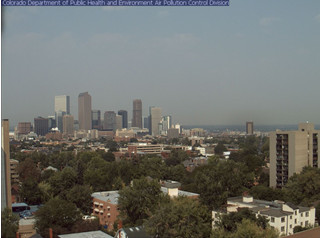
Update, 5:30pm – The Colorado Department of Public Health and Environment has issued a smoke health advisory for northwest and north-central Colorado. The department warns that residents may wish to limit outside activity, particularly those with heart disease, respiratory illnesses, the very young, and the elderly.
Read the advisory in its entirety at the bottom of this story.
Original post, 9/1/09, 3:54pm: The hazy, orange tinted skies over Denver on Monday were an unusual sight and a result of smoke traveling hundreds of miles from wildfires across the western United States. Satellite imagery released by NASA and the National Oceanic and Atmospheric Administration (NOAA) showed plumes of smoke moving northwest toward Colorado from as far away as Los Angeles.
The National Interagency Fire Center (NIFC) reported 17 fires burning in states from Colorado west. Seven fires in California, three in Utah and two in Colorado are the primary ones causing smoke over the Mile High City.
The largest of the blazes, the Station Fire in the foothills near Los Angeles, exploded to more than 120,000 acres in recent days. In Utah, the Mill Flats Fire burning in the Dixie National Forest grew to more than 10,000 acres.
Colorado reports two wildfires, the largest of which has been dubbed the Tabaguache Creek Fire in the Uncompahgre and Gunnison National Forests. That blaze is six miles north of Nucla and has scorched 1,260 acres.
Altogether, the fires that are actively burning have burned more than 150,000 acres of land. For the entire fire season which runs during the calendar year, 65,140 wildfires have been reported and an estimated 5,303,691 acres – more than 8,000 square miles – have been burned.
Tuesday the smoke has eased some over the Front Range and it should dissipate this evening.
From the Colorado Department of Public Health and Environment:
COLORADO SMOKE ADVISORY & OUTLOOK:
Significant smoke from fires in Canada, Utah, Colorado, California and other western states will cause widespread haze in Colorado on Tuesday and from time-to-time this week. Fine Particulate levels are in the Unhealthy-for-Sensitive-Groups category in Garfield County and are probably in the Unhealthy-for-Sensitive-Groups range in other areas across Northwest and North-central Colorado due to the smoke from the forest fires. The highest concentrations are expected to occur in Northwest and North-central Colorado, generally north of I-70, possibly as far east as the Front Range. Much of the rest of Colorado will see concentrations in the Moderate range. IF VISIBILITY IS LESS THAN 5 MILES IN SMOKE IN YOUR NEIGHBORHOOD, SMOKE HAS REACHED LEVELS THAT ARE UNHEALTHY. If smoke is thick or becomes thick in your neighborhood you may want to remain indoors. This is especially true for those with heart disease, respiratory illnesses, the very young, and the elderly. Consider limiting outdoor activity when moderate to heavy smoke is present. Consider relocating temporarily if smoke is present indoors and is making you ill. Smoke should gradually diminish later this evening in most areas.
For satellite analysis of smoke over the U.S., visit: http://www.firedetect.noaa.gov/viewer.htm
Moderate to heavy smoke is also possible in the vicinity of a fire 6 miles north of Nucla, especially in areas down-valley of the fire during the nighttime and morning hours.
FRONT RANGE AIR QUALITY FORECAST:
Ozone is expected to be in the Moderate to Unhealthy-for-Sensitive-Groups range Tuesday afternoon and evening (with the highest readings in the Denver metro area) and in the Moderate category on Wednesday. Active children, active adults, and people with respiratory illnesses should limit prolonged outdoor exertion from 2 PM until midnight tonight.
Visibility is expected to remain in the Poor Category on Tuesday and Wednesday.
Carbon monoxide levels are expected to remain in the Good category along the Front Range on Tuesday.
Fine particulate matter levels are expected to be in the Moderate category along the Front Range on Tuesday and Wednesday

 We offer in depth coverage of the wildfires and other climate and weather topics on our Denver Weather Examiner pages. Check it out!
We offer in depth coverage of the wildfires and other climate and weather topics on our Denver Weather Examiner pages. Check it out!
OK my daughter was in Denver in January, loved it snow and all froze solid,
rivers under the stiff snow with slight holes in the top in the west mountains,
I am stunned California fires have swept over Denver
even with Climatology understanding I am stunned, to the extent of pollution hazard health, which she will be interested in being BioMedic Science.
Thank you for the reports. This is some bad fire set which California seems to have battled all on its own lately.
Mike Stagg Somerset England hydrology soils
We live in Western Colorado, Ouray County. I could smell the ozone earlier this week. First time ever. Visibilty is 2-5 miles depending on what area you live in, along Hwy 550. I wish this would end soon.